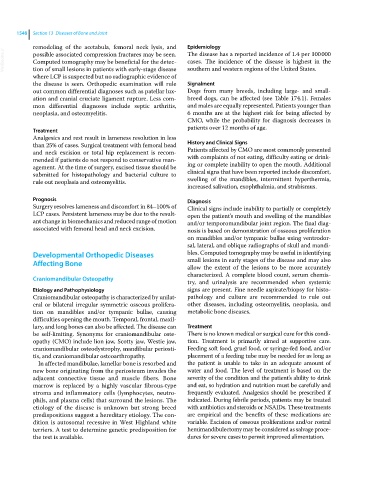Page 1610 - Clinical Small Animal Internal Medicine
P. 1610
1548 Section 13 Diseases of Bone and Joint
remodeling of the acetabula, femoral neck lysis, and Epidemiology
VetBooks.ir possible associated compression fractures may be seen. cases. The incidence of the disease is highest in the
The disease has a reported incidence of 1.4 per 100 000
Computed tomography may be beneficial for the detec-
southern and western regions of the United States.
tion of small lesions in patients with early‐stage disease
where LCP is suspected but no radiographic evidence of
the disease is seen. Orthopedic examination will rule Signalment
out common differential diagnoses such as patellar lux- Dogs from many breeds, including large‐ and small‐
ation and cranial cruciate ligament rupture. Less com- breed dogs, can be affected (see Table 174.1). Females
mon differential diagnoses include septic arthritis, and males are equally represented. Patients younger than
neoplasia, and osteomyelitis. 6 months are at the highest risk for being affected by
CMO, while the probability for diagnosis decreases in
patients over 12 months of age.
Treatment
Analgesics and rest result in lameness resolution in less
than 25% of cases. Surgical treatment with femoral head History and Clinical Signs
and neck excision or total hip replacement is recom- Patients affected by CMO are most commonly presented
mended if patients do not respond to conservative man- with complaints of not eating, difficulty eating or drink-
agement. At the time of surgery, excised tissue should be ing or complete inability to open the mouth. Additional
submitted for histopathology and bacterial culture to clinical signs that have been reported include discomfort,
rule out neoplasia and osteomyelitis. swelling of the mandibles, intermittent hyperthermia,
increased salivation, exophthalmia, and strabismus.
Prognosis Diagnosis
Surgery resolves lameness and discomfort in 84–100% of Clinical signs include inability to partially or completely
LCP cases. Persistent lameness may be due to the result- open the patient’s mouth and swelling of the mandibles
ant change in biomechanics and reduced range of motion and/or temporomandibular joint region. The final diag-
associated with femoral head and neck excision. nosis is based on demonstration of osseous proliferation
on mandibles and/or tympanic bullae using ventrodor-
sal, lateral, and oblique radiographs of skull and mandi-
Developmental Orthopedic Diseases bles. Computed tomography may be useful in identifying
Affecting Bone small lesions in early stages of the disease and may also
allow the extent of the lesions to be more accurately
characterized. A complete blood count, serum chemis-
Craniomandibular Osteopathy
try, and urinalysis are recommended when systemic
Etiology and Pathophysiology signs are present. Fine needle aspirate/biopsy for histo-
Craniomandibular osteopathy is characterized by unilat- pathology and culture are recommended to rule out
eral or bilateral irregular symmetric osseous prolifera- other diseases, including osteomyelitis, neoplasia, and
tion on mandibles and/or tympanic bullae, causing metabolic bone diseases.
difficulties opening the mouth. Temporal, frontal, maxil-
lary, and long bones can also be affected. The disease can Treatment
be self‐limiting. Synonyms for craniomandibular oste- There is no known medical or surgical cure for this condi-
opathy (CMO) include lion jaw, Scotty jaw, Westie jaw, tion. Treatment is primarily aimed at supportive care.
craniomandibular osteodystrophy, mandibular periosti- Feeding soft food, gruel food, or syringe‐fed food, and/or
tis, and craniomandibular osteoarthropathy. placement of a feeding tube may be needed for as long as
In affected mandibulae, lamellar bone is resorbed and the patient is unable to take in an adequate amount of
new bone originating from the periosteum invades the water and food. The level of treatment is based on the
adjacent connective tissue and muscle fibers. Bone severity of the condition and the patient’s ability to drink
marrow is replaced by a highly vascular fibrous‐type and eat, so hydration and nutrition must be carefully and
stroma and inflammatory cells (lymphocytes, neutro- frequently evaluated. Analgesics should be prescribed if
phils, and plasma cells) that surround the lesions. The indicated. During febrile periods, patients may be treated
etiology of the disease is unknown but strong breed with antibiotics and steroids or NSAIDs. These treatments
predispositions suggest a hereditary etiology. The con- are empirical and the benefits of these medications are
dition is autosomal recessive in West Highland white variable. Excision of osseous proliferations and/or rostral
terriers. A test to determine genetic predisposition for hemimandibulectomy may be considered as salvage proce-
the test is available. dures for severe cases to permit improved alimentation.

